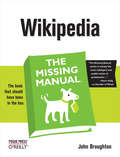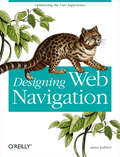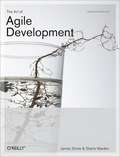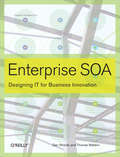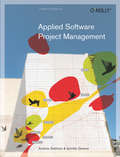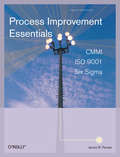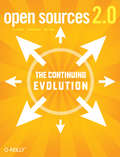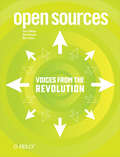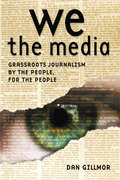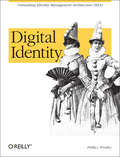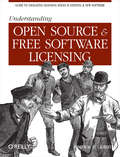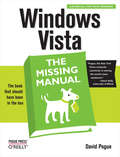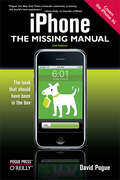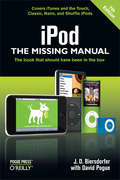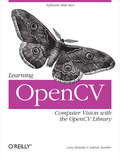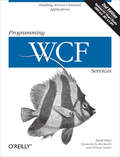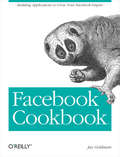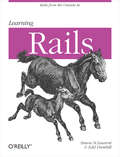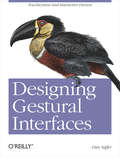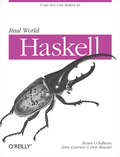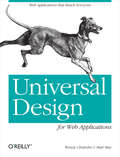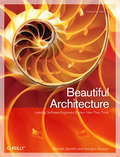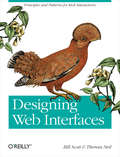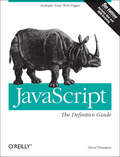- Table View
- List View
Wikipedia: The Missing Manual
by John BroughtonWant to be part of the largest group-writing project in human history? Learn how to contribute to Wikipedia, the user-generated online reference for the 21st century. Considered more popular than eBay, Microsoft.com, and Amazon.com, Wikipedia servers respond to approximately 30,000 requests per second, or about 2.5 billion per day. It's become the first point of reference for people the world over who need a fact fast. If you want to jump on board and add to the content, Wikipedia: The Missing Manual is your first-class ticket. Wikipedia has more than 9 million entries in 250 languages, over 2 million articles in the English language alone. Each one is written and edited by an ever-changing cast of volunteer editors. You can be one of them. With the tips in this book, you'll quickly learn how to get more out of -- and put more into -- this valuable online resource.Wikipedia: The Missing Manual gives you practical advice on creating articles and collaborating with fellow editors, improving existing articles, and working with the Wikipedia community to review new articles, mediate disputes, and maintain the site. Up to the challenge? This one-of-a-kind book includes: Basic editing techniques, including the right and wrong ways to edit Pinpoint advice about which types of articles do and do not belong on Wikipedia Ways to learn from other editors and communicate with them via the site's talk pages Tricks for using templates and timesaving automated editing tools Recommended procedures for fighting spam and vandalism Guidance on adding citations, links, and images to your articles Wikipedia depends on people just like you to help the site grow and maintain the highest quality. With Wikipedia: The Missing Manual, you get all the tools you need to be part of the crew.
Designing Web Navigation
by James KalbachThoroughly rewritten for today's web environment, this bestselling book offers a fresh look at a fundamental topic of web site development: navigation design. Amid all the changes to the Web in the past decade, and all the hype about Web 2.0 and various "rich" interactive technologies, the basic problems of creating a good web navigation system remain. Designing Web Navigation demonstrates that good navigation is not about technology-it's about the ways people find information, and how you guide them. Ideal for beginning to intermediate web designers, managers, other non-designers, and web development pros looking for another perspective, Designing Web Navigation offers basic design principles, development techniques and practical advice, with real-world examples and essential concepts seamlessly folded in. How does your web site serve your business objectives? How does it meet a user's needs? You'll learn that navigation design touches most other aspects of web site development. This book: Provides the foundations of web navigation and offers a framework for navigation design Paints a broad picture of web navigation and basic human information behavior Demonstrates how navigation reflects brand and affects site credibility Helps you understand the problem you're trying to solve before you set out to design Thoroughly reviews the mechanisms and different types of navigation Explores "information scent" and "information shape" Explains "persuasive" architecture and other design concepts Covers special contexts, such as navigation design for web applications Includes an entire chapter on tagging While Designing Web Navigation focuses on creating navigation systems for large, information-rich sites serving a business purpose, the principles and techniques in the book also apply to small sites. Well researched and cited, this book serves as an excellent reference on the topic, as well as a superb teaching guide. Each chapter ends with suggested reading and a set of questions that offer exercises for experiencing the concepts in action.
The Art of Agile Development
by Shane Warden James ShoreThe Art of Agile Development contains practical guidance for anyone considering or applying agile development for building valuable software. Plenty of books describe what agile development is or why it helps software projects succeed, but very few combine information for developers, managers, testers, and customers into a single package that they can apply directly. This book provides no-nonsense advice on agile planning, development, delivery, and management taken from the authors' many years of experience with Extreme Programming (XP). You get a gestalt view of the agile development process, including comprehensive guidance for non-technical readers and hands-on technical practices for developers and testers. The Art of Agile Development gives you clear answers to questions such as: How can we adopt agile development? Do we really need to pair program? What metrics should we report? What if I can't get my customer to participate? How much documentation should we write? When do we design and architect? As a non-developer, how should I work with my agile team? Where is my product roadmap? How does QA fit in? The book teaches you how to adopt XP practices, describes each practice in detail, then discusses principles that will allow you to modify XP and create your own agile method. In particular, this book tackles the difficult aspects of agile development: the need for cooperation and trust among team members. Whether you're currently part of an agile team, working with an agile team, or interested in agile development, this book provides the practical tips you need to start practicing agile development. As your experience grows, the book will grow with you, providing exercises and information that will teach you first to understand the rules of agile development, break them, and ultimately abandon rules altogether as you master the art of agile development. "Jim Shore and Shane Warden expertly explain the practices and benefits of Extreme Programming. They offer advice from their real-world experiences in leading teams. They answer questions about the practices and show contraindications - ways that a practice may be mis-applied. They offer alternatives you can try if there are impediments to applying a practice, such as the lack of an on-site customer. --Ken Pugh, Author of Jolt Award Winner, Prefactoring "I will leave a copy of this book with every team I visit." --Brian Marick, Exampler Consulting
Enterprise SOA
by Dan Woods Thomas MatternInformation Technology professionals can use this book to move beyond the excitement of web services and service oriented architecture (SOA) and begin the process of finding actionable ideas to innovate and create business value. In Enterprise SOA: Designing IT for Business Innovation, SAP's blueprint for putting SOA to work is analyzed from top to bottom. In addition to design, development, and architecture, vital contextual issues such as governance, security, change management, and culture are also explored. This comprehensive perspective reduces risk as IT departments implement ESA, a sound, flexible architecture for adapting business processes in response to changing market conditions. This book answers the following questions: What forces created the need for Enterprise Services Architecture? How does ESA enable business process innovation? How is model-driven development used at all levels of design, configuration, and deployment? How do all the layers of technology that support ESA work together? How will composite applications extend business process automation? How does ESA create new models for IT governance? How can companies manage disruptive change? How can enterprise services be discovered and designed? How will the process of adapting applications be simplified?Based on extensive research with experts from the German software company SAP, this definitive book is ideal for architects, developers, and other IT professionals who want to understand the technology and business relevance of ESA in a detailed way--especially those who want to move on the technology now, rather than in the next year or two.
Applied Software Project Management
by Andrew Stellman Jennifer Greene"If you're looking for solid, easy-to-follow advice on estimation, requirements gathering, managing change, and more, you can stop now: this is the book for you." --Scott Berkun, Author of The Art of Project Management What makes software projects succeed? It takes more than a good idea and a team of talented programmers. A project manager needs to know how to guide the team through the entire software project. There are common pitfalls that plague all software projects and rookie mistakes that are made repeatedly--sometimes by the same people! Avoiding these pitfalls is not hard, but it is not necessarily intuitive. Luckily, there are tried and true techniques that can help any project manager. In Applied Software Project Management, Andrew Stellman and Jennifer Greene provide you with tools, techniques, and practices that you can use on your own projects right away. This book supplies you with the information you need to diagnose your team's situation and presents practical advice to help you achieve your goal of building better software. Topics include: Planning a software project Helping a team estimate its workload Building a schedule Gathering software requirements and creating use cases Improving programming with refactoring, unit testing, and version control Managing an outsourced project Testing software Jennifer Greene and Andrew Stellman have been building software together since 1998. Andrew comes from a programming background and has managed teams of requirements analysts, designers, and developers. Jennifer has a testing background and has managed teams of architects, developers, and testers. She has led multiple large-scale outsourced projects. Between the two of them, they have managed every aspect of software development. They have worked in a wide range of industries, including finance, telecommunications, media, nonprofit, entertainment, natural-language processing, science, and academia. For more information about them and this book, visit http://www.stellman-greene.com.
Process Improvement Essentials
by James R. PersseToday, technology has become too much a part of overall corporate success for its effectiveness to be left to chance. The stakes are too high. Fortunately, the idea of 'quality management' is being reinvigorated. In the last decade process programs have become more and more prevalent. And, out of all the available options, three have moved to the top of the chain. These three are: The 9001:2000 Quality Management Standard from the International Standards Organization; The Capability Maturity Model Integration from the Software Engineering Institute; and Six Sigma, a methodology for improvement shaped by companies such as Motorola, Honeywell, and General Electric.These recognized and proven quality programs are rising in popularity as more technology managers are looking for ways to help remove degrees of risk and uncertainty from their business equations, and to introduce methods of predictability that better ensure success. Process Improvement Essentials combines the foundation needed to understand process improvement theory with the best practices to help individuals implement process improvement initiatives in their organization. The three leading programs: ISO 9001:2000, CMMI, and Six Sigma--amidst the buzz and hype--tend to get lumped together under a common label. This book delivers a combined guide to all three programs, compares their applicability, and then sets the foundation for further exploration. It's a one-stop-shop designed to give you a working orientation to what the field is all about.
Smart Home Hacks
by Gordon MeyerSo much of what is commonplace today was once considered impossible, or at least wishful thinking. Laser beams in the operating room, cars with built-in guidance systems, cell phones with email access. There's just no getting around the fact that technology always has, and always will be, very cool. But technology isn't only cool; it's also very smart. That's why one of the hottest technological trends nowadays is the creation of smart homes. At an increasing rate, people are turning their homes into state-of-the-art machines, complete with more switches, sensors, and actuators than you can shake a stick at. Whether you want to equip your home with motion detectors for added security, install computer-controlled lights for optimum convenience, or even mount an in-home web cam or two purely for entertainment, the world is now your oyster. Ah, but like anything highly technical, creating a smart home is typically easier said than done. Thankfully, Smart Home Hacks takes the guesswork out of the process. Through a seemingly unending array of valuable tips, tools, and techniques, Smart Home Hacks explains in clear detail how to use Mac, Windows, or Linux to achieve the automated home of your dreams. In no time, you'll learn how to turn a loose collection of sensors and switches into a well-automated and well-functioning home no matter what your technical level may be. Smart Home Hacks covers a litany of stand-alone and integrated smart home solutions designed to enhance safety, comfort, and convenience in new and existing homes. Kitchens, bedrooms, home offices, living rooms, and even bathrooms are all candidates for smart automation and therefore are all addressed in Smart Home Hacks. Intelligently written by engineering guru and George Jetson wannabe, Gordon Meyer, Smart Home Hacks leaves no stone unturned. From what to purchase to how to use your remote control, it's the ultimate guide to understanding and implementing complete or partial home automation.
Open Sources 2.0
by Chris Dibona Danese Cooper Mark StoneOpen Sources 2.0 is a collection of insightful and thought-provoking essays from today's technology leaders that continues painting the evolutionary picture that developed in the 1999 book Open Sources: Voices from the Revolution . These essays explore open source's impact on the software industry and reveal how open source concepts are infiltrating other areas of commerce and society. The essays appeal to a broad audience: the software developer will find thoughtful reflections on practices and methodology from leading open source developers like Jeremy Allison and Ben Laurie, while the business executive will find analyses of business strategies from the likes of Sleepycat co-founder and CEO Michael Olson and Open Source Business Conference founder Matt Asay. From China, Europe, India, and Brazil we get essays that describe the developing world's efforts to join the technology forefront and use open source to take control of its high tech destiny. For anyone with a strong interest in technology trends, these essays are a must-read. The enduring significance of open source goes well beyond high technology, however. At the heart of the new paradigm is network-enabled distributed collaboration: the growing impact of this model on all forms of online collaboration is fundamentally challenging our modern notion of community. What does the future hold? Veteran open source commentators Tim O'Reilly and Doc Searls offer their perspectives, as do leading open source scholars Steven Weber and Sonali Shah. Andrew Hessel traces the migration of open source ideas from computer technology to biotechnology, and Wikipedia co-founder Larry Sanger and Slashdot co-founder Jeff Bates provide frontline views of functioning, flourishing online collaborative communities. The power of collaboration, enabled by the internet and open source software, is changing the world in ways we can only begin to imagine.Open Sources 2.0 further develops the evolutionary picture that emerged in the original Open Sources and expounds on the transformative open source philosophy. "This is a wonderful collection of thoughts and examples by great minds from the free software movement, and is a must have for anyone who follows free software development and project histories." --Robin Monks, Free Software Magazine The list of contributors include Alolita Sharma Andrew Hessel Ben Laurie Boon-Lock Yeo Bruno Souza Chris DiBona Danese Cooper Doc Searls Eugene Kim Gregorio Robles Ian Murdock Jeff Bates Jeremy Allison Jesus M. Gonzalez-Barahona Kim Polese Larry Sanger Louisa Liu Mark Stone Mark Stone Matthew N. Asay Michael Olson Mitchell Baker Pamela Jones Robert Adkins Russ Nelson Sonali K. Shah Stephen R. Walli Steven Weber Sunil Saxena Tim O'Reilly Wendy Seltzer
Open Sources
by Chris Dibona Sam OckmanFreely available source code, with contributions from thousands of programmers around the world: this is the spirit of the software revolution known as Open Source. Open Source has grabbed the computer industry's attention. Netscape has opened the source code to Mozilla; IBM supports Apache; major database vendors haved ported their products to Linux. As enterprises realize the power of the open-source development model, Open Source is becoming a viable mainstream alternative to commercial software. Now in Open Sources, leaders of Open Source come together for the first time to discuss the new vision of the software industry they have created. The essays in this volume offer insight into how the Open Source movement works, why it succeeds, and where it is going. For programmers who have labored on open-source projects, Open Sources is the new gospel: a powerful vision from the movement's spiritual leaders. For businesses integrating open-source software into their enterprise, Open Sources reveals the mysteries of how open development builds better software, and how businesses can leverage freely available software for a competitive business advantage. The contributors here have been the leaders in the open-source arena: Brian Behlendorf (Apache) Kirk McKusick (Berkeley Unix) Tim O'Reilly (Publisher, O'Reilly & Associates) Bruce Perens (Debian Project, Open Source Initiative) Tom Paquin and Jim Hamerly (mozilla.org, Netscape) Eric Raymond (Open Source Initiative) Richard Stallman (GNU, Free Software Foundation, Emacs) Michael Tiemann (Cygnus Solutions) Linus Torvalds (Linux) Paul Vixie (Bind) Larry Wall (Perl) This book explains why the majority of the Internet's servers use open- source technologies for everything from the operating system to Web serving and email. Key technology products developed with open-source software have overtaken and surpassed the commercial efforts of billion dollar companies like Microsoft and IBM to dominate software markets. Learn the inside story of what led Netscape to decide to release its source code using the open-source mode. Learn how Cygnus Solutions builds the world's best compilers by sharing the source code. Learn why venture capitalists are eagerly watching Red Hat Software, a company that gives its key product -- Linux -- away. For the first time in print, this book presents the story of the open- source phenomenon told by the people who created this movement. Open Sources will bring you into the world of free software and show you the revolution.
We the Media
by Dan Gillmor"We the Media, has become something of a bible for those who believe the online medium will change journalism for the better." -Financial Times Big Media has lost its monopoly on the news, thanks to the Internet. Now that it's possible to publish in real time to a worldwide audience, a new breed of grassroots journalists are taking the news into their own hands. Armed with laptops, cell phones, and digital cameras, these readers-turned-reporters are transforming the news from a lecture into a conversation. In We the Media, nationally acclaimed newspaper columnist and blogger Dan Gillmor tells the story of this emerging phenomenon and sheds light on this deep shift in how we make--and consume--the news. Gillmor shows how anyone can produce the news, using personal blogs, Internet chat groups, email, and a host of other tools. He sends a wake-up call to newsmakers-politicians, business executives, celebrities-and the marketers and PR flacks who promote them. He explains how to successfully play by the rules of this new era and shift from "control" to "engagement." And he makes a strong case to his fell journalists that, in the face of a plethora of Internet-fueled news vehicles, they must change or become irrelevant. Journalism in the 21st century will be fundamentally different from the Big Media oligarchy that prevails today. We the Media casts light on the future of journalism, and invites us all to be part of it. Dan Gillmor is founder of Grassroots Media Inc., a project aimed at enabling grassroots journalism and expanding its reach. The company's first launch is Bayosphere.com, a site "of, by, and for the San Francisco Bay Area." Dan Gillmor is the founder of the Center for Citizen Media, a project to enable and expand reach of grassroots media. From 1994-2004, Gillmor was a columnist at the San Jose Mercury News, Silicon Valley's daily newspaper, and wrote a weblog for SiliconValley.com. He joined the Mercury News after six years with the Detroit Free Press. Before that, he was with the Kansas City Times and several newspapers in Vermont. He has won or shared in several regional and national journalism awards. Before becoming a journalist he played music professionally for seven years.
Digital Identity
by Phillip J. WindleyThe rise of network-based, automated services in the past decade has definitely changed the way businesses operate, but not always for the better. Offering services, conducting transactions and moving data on the Web opens new opportunities, but many CTOs and CIOs are more concerned with the risks. Like the rulers of medieval cities, they've adopted a siege mentality, building walls to keep the bad guys out. It makes for a secure perimeter, but hampers the flow of commerce. Fortunately, some corporations are beginning to rethink how they provide security, so that interactions with customers, employees, partners, and suppliers will be richer and more flexible. Digital Identity explains how to go about it. This book details an important concept known as "identity management architecture" (IMA): a method to provide ample protection while giving good guys access to vital information and systems. In today's service-oriented economy, digital identity is everything. IMA is a coherent, enterprise-wide set of standards, policies, certifications and management activities that enable companies like yours to manage digital identity effectively--not just as a security check, but as a way to extend services and pinpoint the needs of customers. Author Phil Windley likens IMA to good city planning. Cities define uses and design standards to ensure that buildings and city services are consistent and workable. Within that context, individual buildings--or system architectures--function as part of the overall plan. With Windley's experience as VP of product development for Excite@Home.com and CIO of Governor Michael Leavitt's administration in Utah, he provides a rich, real-world view of the concepts, issues, and technologies behind identity management architecture. How does digital identity increase business opportunity? Windley's favorite example is the ATM machine. With ATMs, banks can now offer around-the-clock service, serve more customers simultaneously, and do it in a variety of new locations. This fascinating book shows CIOs, other IT professionals, product managers, and programmers how security planning can support business goals and opportunities, rather than holding them at bay.
Understanding Open Source and Free Software Licensing
by Andrew M. St. LaurentIf you've held back from developing open source or free software projects because you don't understand the implications of the various licenses, you're not alone. Many developers believe in releasing their software freely, but have hesitated to do so because they're concerned about losing control over their software. Licensing issues are complicated, and both the facts and fallacies you hear word-of-mouth can add to the confusion. Understanding Open Source and Free Software Licensing helps you make sense of the different options available to you. This concise guide focuses on annotated licenses, offering an in-depth explanation of how they compare and interoperate, and how license choices affect project possibilities. Written in clear language that you don't have to be a lawyer to understand, the book answers such questions as: What rights am I giving up? How will my use of OS/FS licensing affect future users or future developers? Does a particular use of this software--such as combining it with proprietary software--leave me vulnerable to lawsuits? Following a quick look at copyright law, contracts, and the definition of "open source," the book tackles the spectrum of licensing, including:The MIT (or X), BSD, Apache and Academic Free licenses The GPL, LGPL, and Mozilla licenses The QT, Artistic, and Creative Commons licenses Classic Proprietary licenses Sun Community Source license and Microsoft Shared Source project The book wraps up with a look at the legal effects--both positive and negative--of open source/free software licensing. Licensing is a major part of what open source and free software are all about, but it's still one of the most complicated areas of law. Even the very simple licenses are tricky. Understanding Open Source and Free Software Licensing bridges the gap between the open source vision and the practical implications of its legal underpinnings. If open source and free software licenses interest you, this book will help you understand them. If you're an open source/free software developer, this book is an absolute necessity.
Windows Vista: The Missing Manual
by David PogueWindows Vista is Microsoft's most important software release in more than a decade. It offers users an abundance of new and upgraded features that were more than five years in the making: a gorgeous, glass-like visual overhaul; superior searching and organization tools; a multimedia and collaboration suite; and above all, a massive, top-to-bottom security-shield overhaul. There's scarcely a single feature of the older versions of Windows that hasn't been tweaked, overhauled, or replaced entirely. But when users first encounter this beautiful new operating system, there's gonna be a whole lotta head-scratchin', starting with trying to figure out which of the five versions of Vista is installed on the PC (Home, Premium, Business, Enterprise, Ultimate). Thankfully, Windows Vista: The Missing Manual offers coverage of all five versions. Like its predecessors, this book from New York Times columnist, bestselling author, and Missing Manuals creator David Pogue illuminates its subject with technical insight, plenty of wit, and hardnosed objectivity for beginners, veteran standalone PC users, and those who know their way around a network. Readers will learn how to:Navigate Vista's elegant new desktop Locate anything on your hard drive quickly with the fast, powerful, and fully integrated search function Use the Media Center to record TV and radio, present photos, play music, and record any of the above to DVD Chat, videoconference, and surf the Web with the vastly improved Internet Explorer 7 tabbed browser Build a network for file sharing, set up workgroups, and connect from the road Protect your PC and network with Vista's beefed up security And much more. This jargon-free guide explains Vista's features clearly and thoroughly, revealing which work well and which don't. It's the book that should have been in the box!
iPhone: Covers the iPhone 3G
by David PogueThe new iPhone 3G is here, and New York Times tech columnist David Pogue is on top of it with a thoroughly updated edition of iPhone: The Missing Manual. With its faster downloads, touch-screen iPod, and best-ever mobile Web browser, the new affordable iPhone is packed with possibilities. But without an objective guide like this one, you'll never unlock all it can do for you.In this new edition, there are new chapters on the App Store, with special troubleshooting and sycning issues with iTunes; Apple's new MobileMe service, and what it means to the iPhone; and Microsoft Exchange ActiveSync compatibility.Each custom designed page in iPhone: The Missing Manual helps you accomplish specific tasks with complete step-by-step instructions for everything from scheduling to web browsing to watching videos. You'll learn how to:Use the iPhone as a phone -- get a guided tour of 3G's phone features and learn how much time you can save with things like Visual Voicemail, contact searching, and moreFigure out what 3G means and how it affects battery life, internet speed, and even phone call audio quality.Treat the iPhone as an iPod -- listen to music, upload and view photos, and fill the iPhone with TV shows and moviesTake the iPhone online -- learn how to get online, use email, browse the Web, and use the GPSGo beyond the iPhone -- discover how to use iPhone with iTunes, sync it with your calendar, and learn about The App Store where you can pick from hundreds of iPhone-friendly programsTeeming with high-quality color graphics and filled with humor, tips, tricks, and surprises, iPhone: The Missing Manual quickly teaches you how to set up, accessorize, and troubleshoot your iPhone. Instead of fumbling around, take advantage of this device with the manual that should have been in the box. It's your call.
iPod: The Missing Manual
by David Pogue J. D. BiersdorferWith the tiny Shuffle, the Nano, the Classic, and the Touch, Apple's gotten the world hooked on portable music, pictures, videos -- and the iPod. One thing they haven't delivered, though, is an easy guide for getting the most from this sleek entertainment center. Enter iPod: The Missing Manual, 7th Edition -- a book as breathtaking, satisfying, and reliable as its subject. Now in a sleek, travel-friendly size, this new edition provides a no-nonsense view of iTunes 8 and everything in the latest iPod line, with crystal-clear explanations, easy-to-follow color graphics, and guidance on all the amazing things you can do, including:Out of the box and into your ears. Find out how to install iTunes and load music on your iPod. And get advice on buying copy-protection free songs from stores like Amazon and Rhapsody.Bopping around the iPod. Learn everything from turning it on and off to shaking your iPod Nano to shuffle your tracks.In tune with iTunes. Choose which parts of your iTunes library loads onto your iPod, move your sacred iTunes Folder to a bigger hard drive, and add album covers to your collection.Picking playlists like a Genius. Let iTunes' new Genius feature whip up smart playlists from your library, and suggest songs from the iTunes Store that fit with what you already own.The power of the 'Pod. Download movies and TV shows and learn how to play them on your iPod and finish viewing them on your TV. Play photo slideshows, find cool podcasts, and more.Welcome to the App Store. Soup up your iPod Touch, from upgrading to the 2.0 firmware to installing the iTunes Store's nifty new collection of programs -- including games that turn the Touch into a pocket 3-D arcade.Even if you don't buy one of the new iPod models, this Missing Manual has plenty of information on the latest version of iTunes, the App Store and a whole lot more about Apple's incredible device.
Learning OpenCV
by Gary Bradski Adrian Kaehler"This library is useful for practitioners, and is an excellent tool for those entering the field: it is a set of computer vision algorithms that work as advertised." -William T. Freeman, Computer Science and Artificial Intelligence Laboratory, Massachusetts Institute of Technology Learning OpenCV puts you in the middle of the rapidly expanding field of computer vision. Written by the creators of the free open source OpenCV library, this book introduces you to computer vision and demonstrates how you can quickly build applications that enable computers to "see" and make decisions based on that data. Computer vision is everywhere-in security systems, manufacturing inspection systems, medical image analysis, Unmanned Aerial Vehicles, and more. It stitches Google maps and Google Earth together, checks the pixels on LCD screens, and makes sure the stitches in your shirt are sewn properly. OpenCV provides an easy-to-use computer vision framework and a comprehensive library with more than 500 functions that can run vision code in real time. Learning OpenCV will teach any developer or hobbyist to use the framework quickly with the help of hands-on exercises in each chapter. This book includes: A thorough introduction to OpenCV Getting input from cameras Transforming images Segmenting images and shape matching Pattern recognition, including face detection Tracking and motion in 2 and 3 dimensions 3D reconstruction from stereo vision Machine learning algorithms Getting machines to see is a challenging but entertaining goal. Whether you want to build simple or sophisticated vision applications, Learning OpenCV is the book you need to get started.
Programming WCF Services
by Juval LowyProgramming WCF Services is the authoritative, bestselling introduction to Microsoft's unified platform for developing service-oriented applications (SOA) on Windows. Hailed as the most definitive treatment of WCF available, this relentlessly practical book provides insight, not documentation, to help you learn the topics and skills you need for building WCF-based applications that are maintainable, extensible, and reusable. Author Juval Lowy, Microsoft software legend and participant in WCF's original strategic design review, revised this new edition for the latest productivity-enhancing features of C# 3.0 and the .NET 3.5 SP1 Framework. The book also contains Lowy's ServiceModelEx, a framework of useful utilities, tools, and helper classes that let you simplify and automate many tasks, and extend WCF as well. With this book, you will:Learn about WCF architecture and essential building blocks, including key concepts such as reliability and transport sessionUse built-in features such as service hosting, instance management, concurrency management, transactions, disconnected queued calls, and securityTake advantage of relevant design options, tips, and best practices in Lowy's ServiceModelEx framework to increase your productivity and the quality of your WCF servicesLearn the rationale behind particular design decisions, and discover poorly documented and little-understood aspects of SOA developmentBy teaching you the "why" along with the "how" of WCF programming, Programming WCF Services not only will help you master WCF, it will enable you to become a better software engineer.
Facebook Cookbook
by Jay GoldmanWant to build Facebook applications that truly stand out among the thousands already available? In addition to providing easy-to-follow recipes that offer practical ways to design and build scalable applications using the Facebook Platform and its new profile design, this Cookbook also explains proven strategies for attracting users in this highly competitive environment. With plenty of examples and practical solutions, Facebook Cookbook answers some of the hardest questions Facebook application developers contend with -- including how and where to get started. This Cookbook will help you: Learn to build an application that scales to accommodate a sudden influx of users Explore changes from Facebook's old profile design to the new look and feel Take advantage of new integration points in the new profile design Get tips for designing applications with hosting and deployment costs in mind Discover which widgets and controls to use for building the most attractive user interface design Learn the differences between standard HTML, JavaScript, and SQL, and the versions used on the Facebook Platform Target large, defined groups on Facebook, including those who want to find jobs, hire employees, market a business, advertise, and more If you can build simple web applications with HTML, Facebook Cookbook will help you build applications with the potential to reach millions of users around the globe. Learn what it takes to design applications that stand above the rest.
Learning Rails
by Simon St. Laurent Edd DumbillWhile most books written about Rails cater to programmers looking for information on data structures, Learning Rails targets web developers whose programming experience is tied directly to the Web. Rather than begin with the inner layers of a Rails web application--the models and controllers--this unique book approaches Rails development from the outer layer: the application interface. You'll learn how to create something visible with Rails before reaching the more difficult database models and controller code. With Learning Rails, you can start from the foundations of web design you already know, and then move more deeply into Ruby, objects, and database structures. This book will help you: Present web content by building an application with a basic view and a simple controller, while learning Ruby along the way Build forms and process their results, progressing from the simple to the more complex Connect forms to models by setting up a database, and use Rails' ActiveRecord to create code that maps to database structures Use Rails scaffolding to build applications from a view-centric perspective Add common web application elements such as sessions, cookies, and authentication Build applications that combine data from multiple tables Create simple but dynamic interfaces with Rails and Ajax Once you complete Learning Rails, you'll be comfortable working with the Rails web framework, and you'll be well on your way to becoming a Rails guru.
Designing Gestural Interfaces: Touchscreens and Interactive Devices
by Dan SafferIf you want to get ahead in this new era of interaction design, this is the reference you need. Nintendo's Wii and Apple's iPhone and iPod Touch have made gestural interfaces popular, but until now there's been no complete source of information about the technology. Designing Gestural Interfaces provides you with essential information about kinesiology, sensors, ergonomics, physical computing, touchscreen technology, and new interface patterns -- all you need to know to augment your existing skills in "traditional" web design, software, or product development. Packed with informative illustrations and photos, this book helps you: Get an overview of technologies surrounding touchscreens and interactive environments Learn the process of designing gestural interfaces, from documentation to prototyping to communicating to the audience what the product does Examine current patterns and trends in touchscreen and gestural design Learn about the techniques used by practicing designers and developers today See how other designers have solved interface challenges in the past Look at future trends in this rapidly evolving field Only six years ago, the gestural interfaces introduced in the film Minority Report were science fiction. Now, because of technological, social, and market forces, we see similar interfaces deployed everywhere. Designing Gestural Interfaces will help you enter this new world of possibilities.
Real World Haskell
by Donald Bruce Stewart John Goerzen Bryan O'SullivanThis easy-to-use, fast-moving tutorial introduces you to functional programming with Haskell. You'll learn how to use Haskell in a variety of practical ways, from short scripts to large and demanding applications. Real World Haskell takes you through the basics of functional programming at a brisk pace, and then helps you increase your understanding of Haskell in real-world issues like I/O, performance, dealing with data, concurrency, and more as you move through each chapter. With this book, you will: Understand the differences between procedural and functional programming Learn the features of Haskell, and how to use it to develop useful programs Interact with filesystems, databases, and network services Write solid code with automated tests, code coverage, and error handling Harness the power of multicore systems via concurrent and parallel programming You'll find plenty of hands-on exercises, along with examples of real Haskell programs that you can modify, compile, and run. Whether or not you've used a functional language before, if you want to understand why Haskell is coming into its own as a practical language in so many major organizations, Real World Haskell is the best place to start.
Universal Design for Web Applications
by Wendy Chisholm Matt MayUniversal Design for Web Applications teaches you how to build websites that are more accessible to people with disabilities and explains why doing so is good business. It takes more work up front, but the potential payoff is huge -- especially when mobile users need to access your sites. You'll discover how to use standards-based web technologies -- such as XHTML, CSS, and Ajax, along with video and Flash -- to develop applications for a wide range of users and a variety of devices, including the mobile Web. You'll also learn specifics about this target audience, especially the key over-50 age group, whose use of the Web is rapidly growing. With this book, you will: Learn the importance of metadata and how it affects images, headings, and other design elements Build forms that accommodate cell phones, screen readers, word prediction, and more Create designs using color and text that are effective in a variety of situations Construct tables that present information without spatial cues Design Ajax-driven social networking applications that people with disabilities can access Provide audio with transcriptions and video that includes captions and audio descriptions Discover assistive technology support for Rich Internet Application technologies such as Flash, Flex, and Silverlight Universal Design for Web Applications provides you with a roadmap to help you design easy-to-maintain web applications that benefit a larger audience.
Beautiful Architecture
by Georgios Gousios Diomidis SpinellisWhat are the ingredients of robust, elegant, flexible, and maintainable software architecture? Beautiful Architecture answers this question through a collection of intriguing essays from more than a dozen of today's leading software designers and architects. In each essay, contributors present a notable software architecture, and analyze what makes it innovative and ideal for its purpose. Some of the engineers in this book reveal how they developed a specific project, including decisions they faced and tradeoffs they made. Others take a step back to investigate how certain architectural aspects have influenced computing as a whole. With this book, you'll discover: How Facebook's architecture is the basis for a data-centric application ecosystem The effect of Xen's well-designed architecture on the way operating systems evolve How community processes within the KDE project help software architectures evolve from rough sketches to beautiful systems How creeping featurism has helped GNU Emacs gain unanticipated functionality The magic behind the Jikes RVM self-optimizable, self-hosting runtime Design choices and building blocks that made Tandem the choice platform in high-availability environments for over two decades Differences and similarities between object-oriented and functional architectural views How architectures can affect the software's evolution and the developers' engagement Go behind the scenes to learn what it takes to design elegant software architecture, and how it can shape the way you approach your own projects, with Beautiful Architecture.
Designing Web Interfaces
by Bill Scott Theresa NeilWant to learn how to create great user experiences on today's Web? In this book, UI experts Bill Scott and Theresa Neil present more than 75 design patterns for building web interfaces that provide rich interaction. Distilled from the authors' years of experience at Sabre, Yahoo!, and Netflix, these best practices are grouped into six key principles to help you take advantage of the web technologies available today. With an entire section devoted to each design principle, Designing Web Interfaces helps you: Make It Direct-Edit content in context with design patterns for In Page Editing, Drag & Drop, and Direct Selection Keep It Lightweight-Reduce the effort required to interact with a site by using In Context Tools to leave a "light footprint" Stay on the Page-Keep visitors on a page with overlays, inlays, dynamic content, and in-page flow patterns Provide an Invitation-Help visitors discover site features with invitations that cue them to the next level of interaction Use Transitions-Learn when, why, and how to use animations, cinematic effects, and other transitions React Immediately-Provide a rich experience by using lively responses such as Live Search, Live Suggest, Live Previews, and more Designing Web Interfaces illustrates many patterns with examples from working websites. If you need to build or renovate a website to be truly interactive, this book gives you the principles for success.
JavaScript: The Definitive Guide
by David FlanaganThis Fifth Edition is completely revised and expanded to cover JavaScript as it is used in today's Web 2.0 applications. This book is both an example-driven programmer's guide and a keep-on-your-desk reference, with new chapters that explain everything you need to know to get the most out of JavaScript, including: Scripted HTTP and AjaxXML processingClient-side graphics using the canvas tagNamespaces in JavaScript--essential when writing complex programsClasses, closures, persistence, Flash, and JavaScript embedded in Java applicationsPart I explains the core JavaScript language in detail. If you are new to JavaScript, it will teach you the language. If you are already a JavaScript programmer, Part I will sharpen your skills and deepen your understanding of the language.Part II explains the scripting environment provided by web browsers, with a focus on DOM scripting with unobtrusive JavaScript. The broad and deep coverage of client-side JavaScript is illustrated with many sophisticated examples that demonstrate how to:Generate a table of contents for an HTML documentDisplay DHTML animationsAutomate form validationDraw dynamic pie chartsMake HTML elements draggableDefine keyboard shortcuts for web applicationsCreate Ajax-enabled tool tipsUse XPath and XSLT on XML documents loaded with AjaxAnd much morePart III is a complete reference for core JavaScript. It documents every class, object, constructor, method, function, property, and constant defined by JavaScript 1.5 and ECMAScript Version 3.Part IV is a reference for client-side JavaScript, covering legacy web browser APIs, the standard Level 2 DOM API, and emerging standards such as the XMLHttpRequest object and the canvas tag.More than 300,000 JavaScript programmers around the world have madethis their indispensable reference book for building JavaScript applications."A must-have reference for expert JavaScript programmers...well-organized and detailed."-- Brendan Eich, creator of JavaScript
